History Of Gurkha Soldier Terms And Conditions Of Service Tri-Partite Treat Of 1947
THE
BEGINNING - GURKHAS, NEPAL AND THE EAST INDIA COMPANY
Prithwi Narayan Shah and his successors
grew so powerful that they overran the whole of the hill country from the
Kashmir border in the west to Bhutan in the east. Eventually, as a
result of boundary disputes and repeated raids by Gurkha columns into
British territory, the Governor General declared war on Nepal in
1814. After two long and bloody campaigns a Peace Treaty was signed
at Sugauli in 1816.
During the war a deep feeling of mutual respect and admiration had developed between the British and their adversaries, the British being much impressed by the fighting and other qualities of the Gurkha soldier. Under the terms of the Peace Treaty large numbers of Gurkhas were permitted to volunteer for service in the East India Company's Army. From these volunteers were formed the first regiments of the Gurkha Brigade, and from this time stems Britain's friendship with Nepal, a country which has proved a staunch ally ever since and has become our 'oldest ally' in Asia. Nevehas the trust that was then placed in the Gurkha soldier ever been in doubt. Alongside his British comrade in arms he has fought in many parts of the world and has proved himself to be of the closest of friends and bravest of allies that Britain has known.
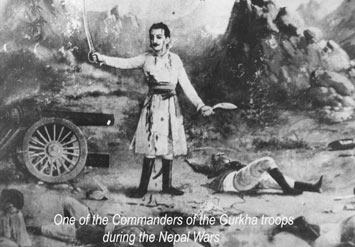
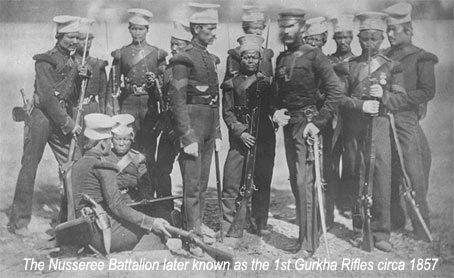
Throughout the next 50 years there was much active service in Burma, Afghanistan, the North-East and the North-West Frontiers of India, Malta, Cyprus, Malaya, China (the Boxer Rebellion of 1900) and Tibet (Younghusband's Expedition of 1903).
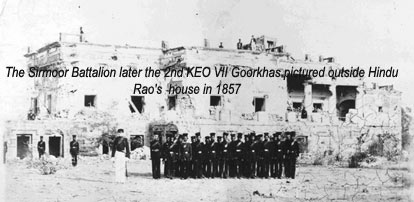
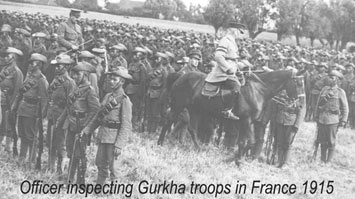
At the outbreak of the First World War the whole of the Nepalese Army was placed at the disposal of the British Crown. Over 16,000 Nepalese Troops were subsequently deployed on operations on the North West Frontier and as Garrison Battalions in India to replace troops of the British Indian Army who had gone to fight overseas.
Some one hundred
thousand Gurkhas enlisted in Regiments of The Gurkhas Brigade. They
fought and died in France and Flanders, Mesopotamia, Persia, Egypt,
Gallipoli, Palestine and Salonika. A battalion of the 8th Gurkhas
greatly distinguished itself as Loos, fighting to the last, and in the
words of the Indian Corps Commander, "found its Valhalla".
The 6th Gurkhas gained immortal fame at Gallipoli during the capture from
the Turks of the feature later known as "Gurkha Bluff". At
Sari Bair they were the only troops in the whole campaign to reach and
hold the crest line and look down on the Straits which was the ultimate
objective. To quote from Field Marshal Sir William Slim's
introduction to the second volume of the 6th Gurkhas' history:
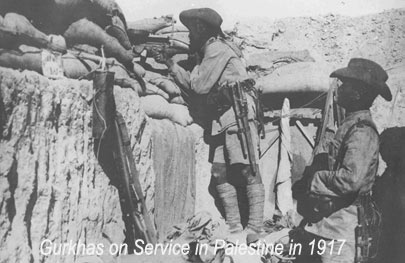
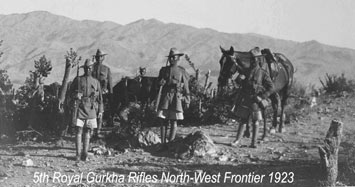
There was little respite after the First World War, with fighting in the Third Afghan War in 1919 followed by numerous campaigns on the North-West Frontier, particularly in Waziristan. Four Nepalese Army Regiments also took part in operations on the North-West Frontier during the Third Afghan War.
THE
SECOND WORLD WAR
In the Second World War there were no fewer than 40 Gurkha Battalions in British Service, as well as parachute, garrison and training units. In all this total sum 112,000 men. Side by side with British and Commonwealth troops Gurkhas fought in Syria, the Western Desert, Italy and Greece, from North Malaya to Singapore and from the Siamese Border back through Burma to Imphal and then forward to Rangoon.
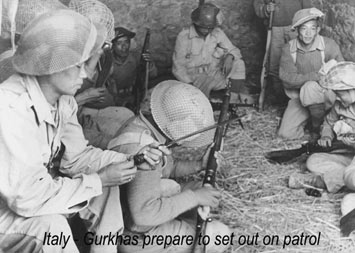
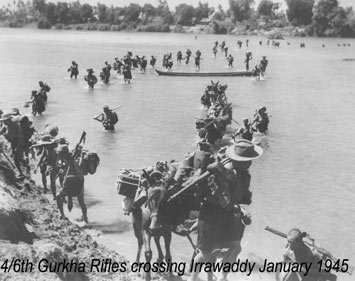
THE PARTITION OF INDIA AND
TRANSFER TO THE BRITISH ARMY
After the Second
World War conflicts in Palestine, The Dutch East Indies, French Indo
China, Borneo and the troubled partition of India claimed the attention
and often the lives of officers and men of the Gurkha Brigade.
At the time of the
partition of India there were 10 Gurkha regiments in the Indian Army, each
regiment consisted of a number of battalions. As a result of
negotiations between the Nepalese, British and Indian Governments (known
as the 'Tri-Partite Agreement') four of these regiments, each of two
battalions were transferred to the British Army, the remainder staying
with the new Indian Army. Thus on 1st January 1948, four Gurkha
regiments became, for the first time, an integral part of the British
Army, forming the Brigade of Gurkhas. These regiments were:
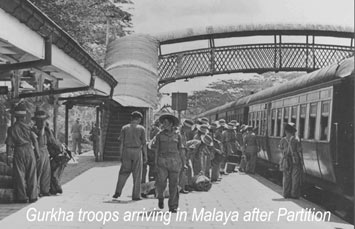
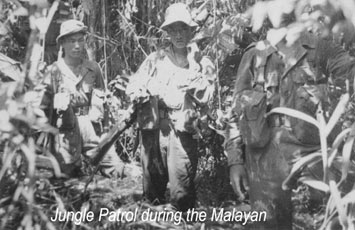
2nd King
Edward VII's Own Gurkha Rifles (The Sirmoor Rifles)
6th Gurkha Rifles (later Queen Elizabeth's Own)
7th Gurkha Rifles (later Duke of Edinburgh's Own)
10th Gurkha Rifles (later Princess Mary's Own)
When these
Regiments moved to the Far East in 1948 they, with other units of the
British Army already there, were formed into a Division which, being
largely Gurkha, was designated 17 Gurkha Infantry Division. After
1948 the following additional Gurkha Units were raised:
Gurkha Engineers (now The Queen's Gurkha Engineers)
Gurkha Signals (now The Queen's Gurkha Signals)
Gurkha Army Service Corps (now The Queen's Own
Gurkha
Logistic Regiment)
Gurkha Independent Parachute Company (disbanded
1972)
Gurkha Military Police (disbanded 1964)
THE
MALAYAN EMERGENCY
The Brigade of Gurkhas operated continuously throughout the Malayan Emergency, for 12 years (1948 to 1960) against communist terrorists, and the Gurkha soldier again proved himself to be, as he had previously done in Burma, a superb jungle fighter. Whilst the majority of the rest of the British Army was fighting in such trouble spots as Korea, Cyprus, Kenya and Aden and maintaining a presence in the UK, Germany and other garrisons in various parts of the world, the Brigade of Gurkhas was providing the backbone, the expertise and the continuity in the campaign in Malaya.
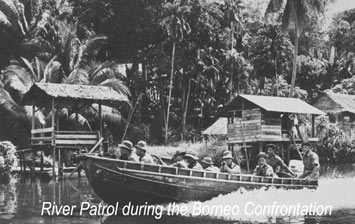
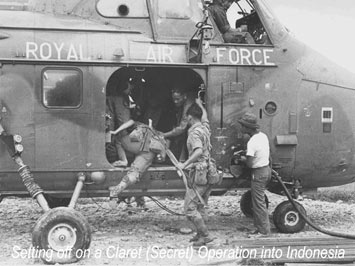
BORNEO -
THE BRUNEI REVOLT AND 'CONFRONTATION' WITH INDONESIA
Gurkha troops (1st
Battalion, 2nd KEO Gurkha Rifles) were the first to be used again in an
operational role at the outbreak of the Brunei Revolt in December 1962.
The battalion was alerted at 11pm on 7th December and the first company
was air landed in Brunei, 900 miles away, at 9am the following morning.
There followed four years on continuous operations against units of the
Indonesian Regular Army in Sabah and Sarawak in which every unit of the
Brigade of Gurkhas took part. As they did in the Malayan Emergency,
Gurkha units again provided the bulk and the continuity of the British
Army's contribution to this campaign. It was in November 1965 that
Lance Corporal Rambahadur Limbu of the 2nd Battalion, 10th PMO Gurkha
Rifles won the Victoria Cross.
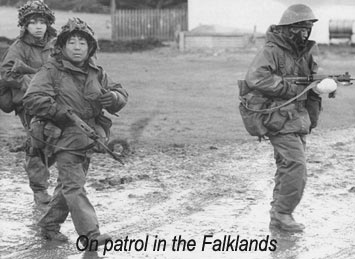
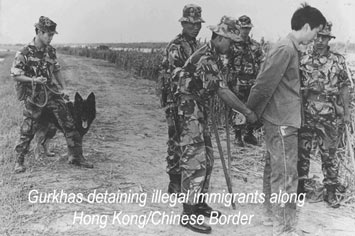
When the Borneo campaign ended in 1966 there was a short lull before the Brigade found itself engaged in internal security tasks in Hong Kong during civil disturbances resulting from Chin'a Cultural Revolution.
When the Borneo campaign ended in 1966 there was a short lull before the Brigade found itself engaged in internal security tasks in Hong Kong during civil disturbances resulting from Chin'a Cultural Revolution.
BRITISH
WITHDRAWAL FROM MALAYSIA AND SINGAPORE AND THE 'RUNDOWN' OF THE BRIGADE OF
GURKHAS
Between 1967 and 1972, as a result of changing defence commitments and the reorganisation of the Armed Forces, the strength of the Brigade of Gurkhas was reduced from 14,000 to about 8,000. This was achieved by a reduction of the number of Gurkha infantry battalions from eight to five, reductions in the strength of the three corps units ( Engineers, Signals and Transport) and the disbandment of the Gurkha Parachute Company and the Gurkha Military Police. When British Forces withdrew from Singapore in 1971 three battalions of Gurkha infantry and the Gurkha Engineers, Gurkha Signals and Gurkha Transport Regiment were stationed in Hong Kong and the remaining two battalions stationed one in the United Kingdom (at Church Crookham) and the other in Brunei. In 1974 the battalion based in England (10th PMO Gurkha Rifles) deployed to Cyprus to reinforce the British Sovereign Base Area when Turkey invaded the island. Since 1978 the United Kingdom based Gurkha battalion has taken its turn in helping to garrison Belize and in 1982 the 1st Batalion 7th DEO Gurkha Rifles took part in the Falkland Islands Campaign. In the Gulf War to liberate Kuwait in 1990/1991, the then Gurkha Transport Regiment provided 28(Ambulance) Squadron and the Band of The Brigade of Gurkhas deployed as stretcher bearers.
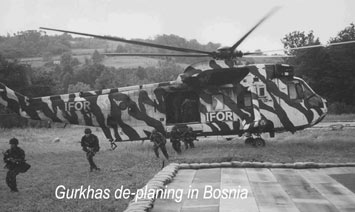
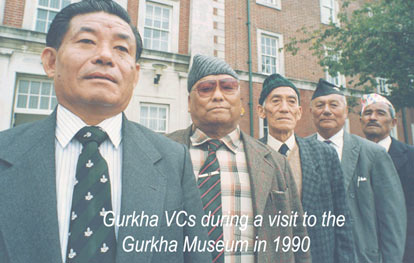
In 1977, during the Sliver Jubilee Year, the Queen honoured three units of the Brigade of Gurkhas. The Gurkha Engineers and Gurkha Signals received Royal titles and His Royal Highness The Prince of Wales was appointed Colonel-in-Chief of the 2nd KEO Gurkha Rifles. In 1992 the Gurkha Transport Regiment was redesignated The Queen's Own Gurkha Transport Regiment. Following the Government's decision to reduce and restructure the Army the Brigade reduced in size from 8,000 to 3,500 by 1998. In 1994 the four Rifle Regiments disbanded and were reformed into a large Regiment, The Royal Gurkha Rifles (RGR) which initially consisted of three battalions. His Royal Highness The Prince of Wales is the Regiment's Colonel-in-Chief. RGR reduced to two battalions in November 1996 when 3 RGR disbanded on the withdrawal of 1 RGR from Hong Kong to UK. At that time three Gurkha Rifle Companies were formed to reinforce the Infantry until 2005. The Brigade is also providing reinforcements for various specialist posts throughout the Army. The Corps Regiments have reduced in size to a Regimental Headquarters and two squadrons each; these squadrons are deployed within the parent corps regiments.
There are currently some 3,400 Gurkhas in the British Army (as at 1 August
2001) organised in the following headquarters and units:
|
HQ
The Brigade of Gurkhas |
Netheravon,
UK |
|
1st
Battalion The Royal Gurkha Rifles |
Tuker
Lines, Seria, Brunei |
|
2nd
Battalion The Royal Gurkha Rifles |
Shorncliffe,
Kent, UK |
|
A
Company, The Highlanders |
Catterick,
UK |
|
D
Company, 1 Royal Irish |
Canterbury,
Kent, UK |
|
C
Company, 2 Para |
Colchester,
UK |
|
The
Queen's Gurkha Engineers |
Maidstone,
Kent UK |
|
The
Queen's Gurkha Signals |
Bramcote,
Nuneaton, UK |
|
The
Queen's Own Gurkha Logistic Regiment |
Colchester,
UK |
|
Gurkha
Demonstration Company |
Camberley,
Surrey, UK |
|
Gurkha
Demonstration Company |
Brecon,
Wales, UK |
|
Gurkha
Company, 3rd Battalion ITC Catterick |
Catterick
Garrison, UK |
|
British
Gurkahs Nepal (a HQ, with Depots in Kathmandu and Pokhara) |
Nepal |
|
The
Band of The Brigade of Gurkhas |
Shorncliffe, Kent, UK |
RECENT
OPERATIONS
The Brigade continues to play a full and active part in contemporary British military operations. The 1st Battalion The Royal Gurkha Rifles were at the forefront of the NATO Peace Support Operations in Kosovo in 1999, whilst in the same year, the 2nd Battalion played a key role in the United Nations Peacekeeping Mission in East Timor. All units of the Brigade have contributed to United Nations and NATO Peace Support Operations in the Balkans over the last decade. The Royal Gurkha Rifles have also been directly committed to British Operations in Sierra Leone, most notably the 2nd Battalion The Royal Gurkha Rifles and 2 PARA Gurkha Reinforcement Company. The 2nd Battalion deploy to Bosnia for six months in late 2001.
CONCLUSION
In the two World
Wars the Gurkha Brigade suffered 43,000 casualties, and to date it has won
26 Victoria Crosses - 13 by Gurkhas and 13 by British Officers. This
short chronicle is of necessity brief and factual. It cannot
adequately portray the spirit and the character of the Gurkha soldier, nor
can it reflect the 'esprit de corps' and the bond of comradeship and
mutual respect which bind together the British and Gurkha Officers and men
of the Brigade. But perhaps these words written by the late Sir
Ralph Turner MC (Professor of Sanskrit at the University of London, Fellow
of Christ's College Cambridge and some time Adjutant of the 2nd Battalion,
3rd Queen Alexandra's Own Gurkha Rifles) in 1931, give a hint of the true
feelings of both sides:
"As I write these words, my thoughts return to you who
were my comrades the stubborn and
indomitable
peasants of Nepal. Once more I hear
the laughter with
which you greeted every hardship.
Once more I see
you in your bivouacs or about your camp
fires, on
forced marches or in the trenches, now
shivering with
wet and cold, now scorched by a pitiless
and burning
sun. Uncomplaining you endure hunger
and thirst and
wounds; and at the last your unwavering
lines disappear
into the smoke and wrath of battle.
Bravest of the brave,
most generous of the generous, never had a
country
more faithful friends than you".